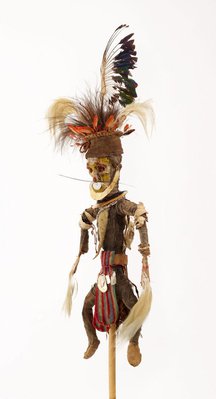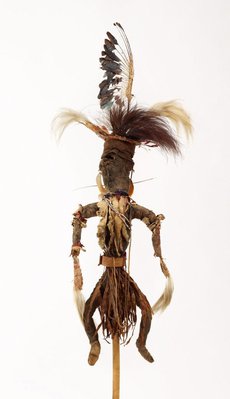

-
Details
- Other Title
- Figure
- Place where the work was made
-
Anglimp-South Waghi District
→
Jiwaka Province
→
Papua New Guinea
- Cultural origin
- Wahgi people
- Dates
- mid 20th century
collected 1965 - Media categories
- Mixed media , Ceremonial object
- Materials used
- wood, bamboo, machine-wove cotton fabric, looped synthetic yarn, plant fibre string, marsupial fur, mammalian skin, coix seeds (Coix lacryma-jobi), feather shaft, gold-lipped oyster shell (Pinctada maxima), cone shell (Conus), parrot feather, Lesser Bird of Paradise (Paradisaea minor), cassowary feathers (Casuarius), red and yellow synthetic pigments, 2 safety pins, printed paper
- Dimensions
- overall 207.0 x 38.0 x 24.0 cm; figure (without headdress) 100.0 cm height
- Credit
- Gift of Stan Moriarty 1977
- Location
- Not on display
- Accession number
- 818.1979
- Copyright
- © Wahgi people, under the endorsement of the Pacific Islands Museums Association's (PIMA) Code of Ethics
- Artist information
-
Ngunts
Works in the collection
- Share
-
-
About
Constructed from an astounding array of natural and manufactured materials, this 'kund gale' (effigy) is dressed in the ceremonial attire of a Wahgi male dancer. It is replete with 'konzap kine', a traditional apron decorated with pearlshells. Made by men, the 'kund gale' is used only during the major pig festival called 'konggar' – an extended ritual cycle held once in a generation. Over a period of years, rites are performed, pigs reared, and ceremonial structures built. During the final days of celebration the correct 'bilas' (body decoration) are worn, including bird of paradise plumes.
On the day before the climax of the festival, when hundreds of pigs are killed and pork distributed to family and exchange partners, men perform 'trampling the fence'. This involves rushing onto the ceremonial ground in a display of martial force with one dancer carrying the 'kund gale' mounted on a pole above his head.
[Exhibition text for 'Plumes and pearlshells: art of the New Guinea highlands', AGNSW, 2014]
-
Exhibition history
Shown in 1 exhibition
Plumes and pearlshells: art of the New Guinea highlands, Art Gallery of New South Wales, Sydney, 30 May 2014–10 Aug 2014
-
Bibliography
Referenced in 2 publications
-
Natalie Wilson (Editor), Plumes and pearlshells: art of the New Guinea highlands, Sydney, 2014, front cover (colour illus., detail), 141 (colour illus.), 163. cat.no. 83
-
Natalie Wilson, Look, 'A myriad of artforms: rare and beautiful objects from the highlands of New Guinea', pg. 24-28, Sydney, May 2014, front cover (colour illus., detail), 11 (colour illus.), 27.
-
